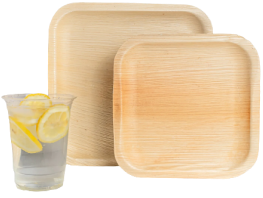Behind the Scenes: Making Bagasse Bowls

How about serving some super-crunchy breakfast cereal in plant-based bliss? We get it, single-use plastics are here, so you won't get caught up in the post-meal mess. But, your convenience should never be heavy on the planet. And, our compostable bagasse bowls are here, so you can indulge guilt-free without feeling bad.
These bowls are plant-based, contain no toxins or chemicals and are certified compostable. Moreover, with no plastic or paper, these tableware products are just perfect to compliment your super bougie, eco-friendly breakfast routine without a pinch of guilt.
That being said, here’s how these plant-based wonders are made.
Wait, What is Bagasse?
Before we get into the antics of bagasse bowls and their making, let’s explore what exactly bagasse is. In a nutshell, bagasse is the byproduct of sugarcane waste. This usually ends in a landfill, but we upcycle the same and excavate the best out of the waste.
Bagasse is a 100% natural material that is extracted from sugarcane stalks once the juice is extracted. And, instead of dumping this agro-waste in landfills, we believe in upcycling plant waste and embracing a circular economy.
In short, our biodegradable bowls are made out of sugarcane bagasse, with absolutely zero interference from plastic and other harmful materials that could harm your food or the ecosystem. These are churned in the most harmless and poised manner possible to maintain the well-being of our surroundings and save the planet for a better tomorrow.
How are these bagasse bowls made?
Well, to start with, the manufacturing process involves multiple steps. So, to understand this in a better and deeper way, let's dive into the process of making bagasse bowls.
A step-by-step guide to the perfect tableware for every occasion: Bagasse Bowls
Extraction of Raw Material: Usually, bagasse is a byproduct of sugarcane, as mentioned earlier. At times, this usually involves machinery to get the exact form that would be required to upcycle it into bagasse products.
Extracting Juice from Stalk: The sugarcane stalks are beaten up to form the byproduct bagasse. To be exact, this is usually in juice form and then later molded to form plates and bowls.
Cleaning and Molding: This fibrous material is further cleaned and processed. During this process, the material, naturally present in bagasse, called lignin, is removed, and the fibre is further processed to get the exact texture required for further moulding into culinary accessories.
Give me the exact pulp I need. (Bagasse): Once we clean the material properly, we further form it into a pulp texture, which is usually done by adding more water and, at times, also requires a machinery process. Once this pulp is precisely achieved, the rest of the process is just a piece of cake. Kidding, it isn't actually, but yes, to achieve a proper bagasse bowl, this process is the most crucial and can't go wrong, so it requires expert supervision.
Heat Pressing and Molding: Once the desired form of pulp is generated, it is moved for further processing. The supply pulp is first cast into a shell of the desired shape. This then involves heat processing to make it more sturdy, as the excess amount of water left behind in the pulp is cleared out.
Final Touch-up: Now that you have already obtained the final product, we go for a touch-up. Well, this typically involves trimming and polishing the disposable bowls as per the desired texture.
Summing It Up

To summarize, overall, bagasse is a better choice for the environment. This material, which usually used to end up in landfills, has now been elevated to an eco-friendly lifestyle choice. This means they are one of the best replacements for those culinary choices that were usually beautiful and the centre of attraction for your gatherings and mostly included toxic mixes that used to harm Mother Nature. Well, if you are looking to buy more plant-based home essentials that are 100% organic, look no further because EcoSoul has got you covered. Not only have bagasse soup bowls, but also other products made out of bagasse as well, like hot cups, bagasse plates in different shapes and sizes, and so on.






